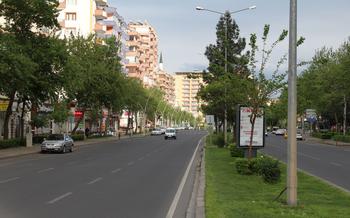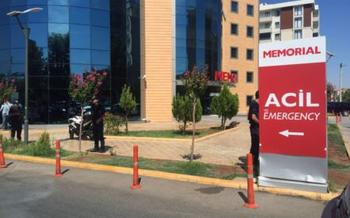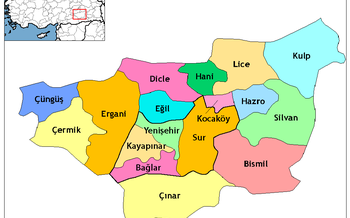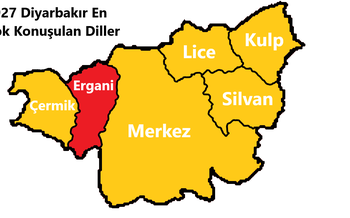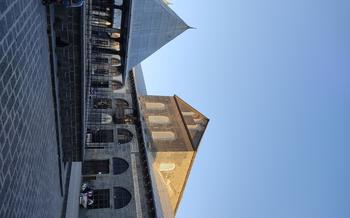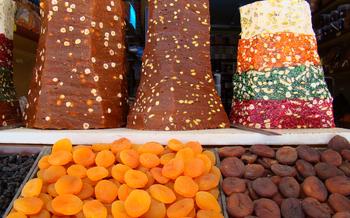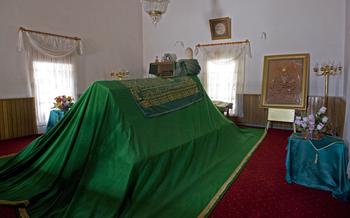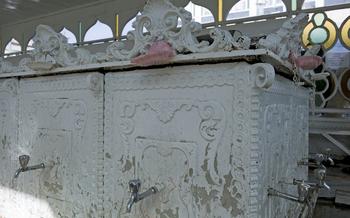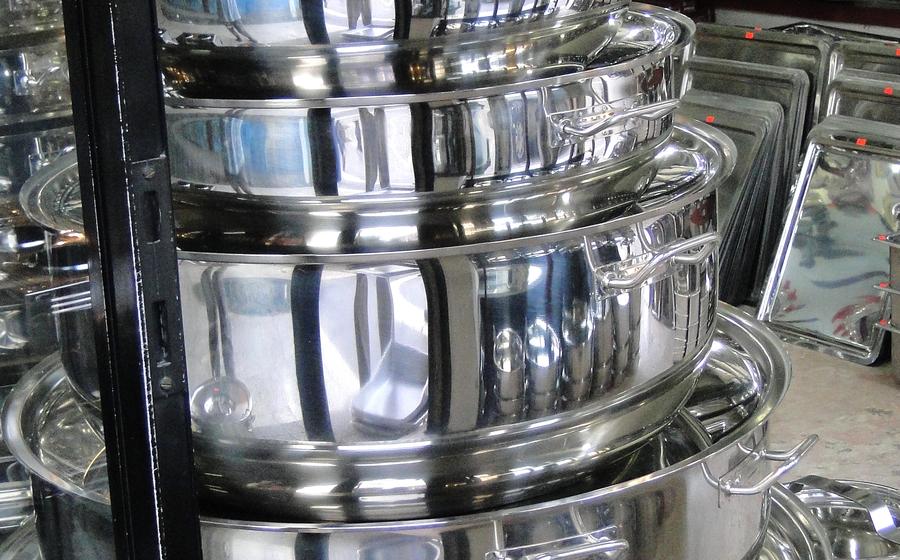
Nebii Mosque
- Historical Significance
- Architecture and Design
- Religious Importance
- Visitor Experience
- Guided Tours
- Photography and Videography
- Souvenirs and Local Crafts
- Local Cuisine
- Accessibility
- Safety and Security
- Etiquette and Respect
- Local Customs and Traditions
- Nearby Attractions
- Insider Tip: The Hidden Courtyard Oasis
Historical Significance
Dating back to the 14th century, the Nebii Mosque in Diyarbakır stands as a testament to the region's rich history and cultural heritage. Constructed during the reign of the Artuqid dynasty, a prominent Muslim dynasty ruling over eastern Anatolia, the mosque has served as a central place of worship for Muslims for centuries. Its architectural grandeur and historical significance have earned it recognition as a UNESCO World Heritage Site, further solidifying its status as a beacon of Islamic architecture and a symbol of Diyarbakır's vibrant past.
Architecture and Design
The Nebii Mosque stands as a testament to the architectural prowess of the Seljuk era. Its striking features include four towering minarets, each adorned with intricate carvings and bands of turquoise tiles. These minarets soar towards the sky, providing a majestic sight from afar. The mosque's domes, crowned with gleaming copper, add to its grandeur and elegance. The courtyard, a serene space surrounded by graceful arches, invites visitors to pause and reflect.
Stepping inside the mosque, one is awestruck by the intricate craftsmanship and symbolism that adorn every corner. The walls are adorned with mesmerizing calligraphy, verses from the Quran inscribed in flowing Arabic script. The mihrab, the niche indicating the qibla, is a masterpiece of artistry, featuring intricate tilework and carvings that draw the eye. The pulpit, from which the imam delivers sermons, is another example of exquisite craftsmanship, with its intricate carvings and inlaid mother-of-pearl.
The mosque's acoustics are a testament to the ingenuity of its builders. The carefully designed interior ensures that the call to prayer, the muezzin's melodic voice, resonates throughout the mosque, creating a powerful and evocative atmosphere that stirs the soul.
Over the centuries, the mosque has undergone meticulous restoration efforts to preserve its architectural integrity. These efforts have ensured that the Nebii Mosque continues to stand as a beacon of Islamic architecture, showcasing the enduring legacy of the Seljuk dynasty.
Religious Importance
The Nebii Mosque stands as a spiritual beacon in Diyarbakır, serving as a central hub for Islamic teachings, practices, and community gatherings. Its hallowed halls have witnessed centuries of devout worship, religious ceremonies, and the dissemination of Islamic knowledge. Notable religious figures and scholars have graced its pulpit, sharing their wisdom and guidance with generations of believers. The mosque's sacred status is further elevated by its recognition as a pilgrimage site, attracting devout Muslims from near and far who seek spiritual solace and connection with their faith.
Visitor Experience
Visiting the Nebii Mosque is an immersive experience that transports you back in time. The mosque is open to visitors daily, and modest dress is expected as a sign of respect for the religious significance of the site. As you step inside, you'll be struck by the serene atmosphere and the intricate details that adorn every corner. Take your time to admire the beautiful calligraphy, the stunning stained-glass windows, and the intricate tilework that covers the walls and ceilings. The mosque's acoustics are also remarkable, enhancing the call to prayer, which reverberates through the vast space.
For the best experience, visit the mosque during the early morning or late afternoon, when the light is at its most beautiful and the crowds are smaller. Combine your visit with a walk through the historic district of Diyarbakır, where you can explore other architectural wonders and soak up the vibrant local culture.
Guided Tours
Enrich your visit to the Nebii Mosque by opting for a guided tour. These tours, available in various languages, provide an immersive and informative experience, allowing you to delve deeper into the mosque's history, architecture, and religious significance. Knowledgeable guides will lead you through the mosque's intricate spaces, explaining the symbolism behind the carvings, the acoustics that enhance the call to prayer, and the mosque's role in the community.
Guided tours typically cover the mosque's architectural highlights, including its minarets, domes, and courtyard, as well as its religious importance as a center for Islamic teachings and practices. You'll learn about the mosque's association with notable religious figures and its status as a pilgrimage site for Muslims.
Booking a guided tour is recommended to gain a comprehensive understanding of the mosque's significance and to ask any questions you may have. Prices and availability vary, so it's advisable to book in advance to secure your spot.
For those who prefer a more independent exploration, audio guides and self-guided tours are also available. These options allow you to explore the mosque at your own pace, with recorded commentary or a printed guide providing information about the mosque's features and history.
Photography and Videography
The Nebii Mosque offers a delightful opportunity for photography and videography enthusiasts to capture stunning images and create captivating content. The mosque's exquisite architecture, intricate carvings, and serene atmosphere make it a treasure trove for visual storytellers. Whether you're an amateur photographer or a professional content creator, the mosque provides ample opportunities to showcase your skills.
When capturing the beauty of the mosque, be sure to adhere to the guidelines and etiquette to maintain a respectful ambiance. Avoid using flash or tripods that may disrupt the tranquility of the space. Also, be mindful of the worshippers and other visitors to ensure they are not disturbed by your activities.
Some of the recommended spots for capturing exceptional shots include the intricate carvings on the minarets, the majestic domes against the backdrop of the sky, and the serene courtyard with its lush greenery. For those seeking a unique perspective, the mosque's rooftop terrace offers panoramic views of the city and the surrounding landscape.
If you wish to take professional photographs or videography for commercial purposes, obtaining special permits from the mosque's administration is advisable. This ensures that your work aligns with the mosque's policies and regulations.
Whether you choose to capture the beauty of the Nebii Mosque through still images or moving pictures, the experience promises to be both inspiring and fulfilling. So bring your camera, embrace your creativity, and let the mosque's grandeur unfold before your lens.
Souvenirs and Local Crafts
The Nebii Mosque area is a treasure trove of authentic souvenirs and local crafts that reflect the region's rich cultural heritage. Visitors can find a variety of shops and stalls near the mosque, offering a diverse selection of handmade items, traditional textiles, and unique souvenirs.
For those seeking a meaningful memento of their visit, consider purchasing a hand-woven carpet or rug, adorned with intricate patterns and vibrant colors. These carpets are often made using traditional techniques passed down through generations and symbolize Turkish craftsmanship.
Another popular souvenir is the Nazar Boncuk, also known as the "evil eye," a blue glass bead believed to protect against negative energy. Visitors can find Nazar Boncuk in various forms, including jewelry, keychains, and home décor items.
For those interested in supporting local artisans, there are stalls selling handmade pottery, ceramics, and jewelry. These items often feature intricate designs inspired by Islamic art and motifs. Bargaining is customary in these markets, so don't hesitate to negotiate a fair price.
When purchasing souvenirs, remember to respect the cultural significance and symbolism of the items. Avoid buying anything that may be considered disrespectful or offensive to local customs and traditions.
Local Cuisine
When exploring the surroundings of the Nebii Mosque, visitors have the opportunity to indulge in the diverse culinary delights that Diyarbakır offers. The region is renowned for its unique flavors and rich culinary traditions, inviting travelers to embark on a gastronomic journey.
Strolling through the vibrant streets near the mosque, visitors will encounter an array of local restaurants, eateries, and food stalls, each offering a tantalizing array of dishes that reflect the region's culinary heritage. From traditional Turkish fare to modern fusion cuisine, there's something to satisfy every palate.
For an authentic experience, visitors should try local dishes such as "kaburga dolması" (stuffed lamb ribs) or "mumbar dolması" (stuffed intestines), which are considered regional specialties. These dishes are skillfully prepared using fresh, local ingredients, showcasing the culinary expertise of the region.
When it comes to restaurants, "ciğerci" (liver restaurants) are a must-visit for meat lovers. These establishments specialize in grilled liver dishes, offering a variety of options to satisfy even the most discerning taste buds.
Vegetarians and vegans can also find delicious options in Diyarbakır. The region's cuisine offers an array of vegetable-based dishes, such as "kısır" (a bulgur salad) and "imam bayıldı" (stuffed eggplant), which are bursting with flavor and local spices.
To navigate the local food scene seamlessly, visitors should be prepared to embrace the local customs and traditions. Bargaining is a common practice in local markets and shops, and visitors can engage in this cultural exchange while purchasing souvenirs or local products.
By immersing themselves in the culinary delights of Diyarbakır, visitors can gain a deeper appreciation for the region's rich culture and heritage, creating lasting memories that extend beyond the mosque's walls.
Accessibility
Ensuring inclusivity and accessibility for all visitors, the Nebii Mosque offers several features to accommodate individuals with disabilities. Wheelchair ramps and elevators provide easy access to different sections of the mosque, including the prayer hall, courtyard, and ablution facilities. Accessible restrooms are also available, ensuring convenience and comfort for visitors with limited mobility. The mosque's staff is trained to assist visitors with disabilities, providing guidance and support throughout their visit. Additionally, guided tours can be arranged in advance, allowing visitors to explore the mosque's history and significance at their own pace and with personalized assistance.
Safety and Security
Ensuring the safety and security of visitors is a top priority at the Nebii Mosque. Visitors can rest assured that comprehensive measures are in place to safeguard their well-being. The mosque is under the watchful eye of a dedicated security team, complemented by a network of surveillance cameras monitoring the premises. These measures provide a secure environment for visitors to explore and appreciate the mosque's beauty and significance without any worries. Additionally, visitors are advised to remain vigilant and aware of their surroundings, adhering to local safety guidelines. By following these simple precautions, visitors can fully immerse themselves in the spiritual and cultural essence of the Nebii Mosque, confident in the knowledge that their safety is well-assured.
Etiquette and Respect
When visiting the Nebii Mosque, it's essential to be mindful of the religious and cultural significance it holds for Muslims. Respectful behavior and attire are expected within the mosque's sacred space. Visitors should dress modestly, with shoulders and knees covered. Women may also choose to cover their hair as a sign of respect. Upon entering the mosque, it's customary to remove shoes and place them on the designated shelves. Maintaining silence and avoiding loud conversations is considered respectful, as the mosque is a place of worship and contemplation. When passing in front of worshippers engaged in prayer, it's polite to do so quietly and without disturbing them. Photography and videography are generally permitted, but visitors should be mindful of not disrupting worshippers or taking photos that may be considered disrespectful. By following these guidelines, visitors can show their respect for the mosque's religious and cultural significance and contribute to a peaceful and harmonious atmosphere for all.
Local Customs and Traditions
When visiting the Nebii Mosque, it's essential to be mindful of local customs and traditions to show respect for the religious and cultural significance of the site. Visitors should dress modestly, covering their shoulders and knees. Women may also choose to cover their heads as a sign of respect. Upon entering the mosque, it is customary to remove one's shoes and place them neatly on the designated shoe racks. Inside the mosque, maintain a respectful demeanor, avoiding loud noises or disruptive behavior. When interacting with locals or fellow visitors, greet them with a friendly "Merhaba" (hello) and a slight nod. Remember that the mosque is a place of worship, so be mindful of ongoing prayers and religious ceremonies. By observing local customs and traditions, visitors can contribute to a respectful and harmonious atmosphere within the mosque.
Nearby Attractions
A visit to the Nebii Mosque can be easily combined with other nearby attractions, allowing you to delve deeper into the city's rich history and vibrant culture. Within walking distance, you'll find the iconic Diyarbakır Fortress, a UNESCO World Heritage Site that has stood watch over the city for centuries. Explore its imposing walls, towers, and gates, and soak in the breathtaking panoramic views from its ramparts.
Adjacent to the mosque, the Diyarbakır Museum houses a fascinating collection of artifacts that shed light on the region's diverse past. From ancient Mesopotamian relics to Islamic manuscripts and Seljuk ceramics, the museum offers a glimpse into the cultural tapestry that has shaped Diyarbakır.
For a unique culinary experience, venture into the narrow streets of the Old City, where you'll find traditional Kurdish restaurants serving up mouthwatering dishes like "kaburga dolması" (stuffed lamb ribs) and "mırra" (a rich coffee brewed with cardamom).
To immerse yourself in the city's vibrant atmosphere, head to the bustling streets of Yenişehir, where you can browse colorful bazaars, sample local delicacies, and mingle with friendly locals.
With so much to offer, Diyarbakır promises an enriching and memorable experience for every visitor.
Insider Tip: The Hidden Courtyard Oasis
Venture beyond the main prayer hall and discover a hidden gem within the Nebii Mosque—a serene courtyard oasis. This tranquil space, adorned with lush gardens and a soothing water fountain, offers a moment of respite from the bustling city. Escape the crowds and find solace amidst the tranquil beauty of this secluded sanctuary. As you sit beneath the shade of the trees, take a moment to appreciate the intricate details of the mosque's architecture reflected in the still waters of the fountain. This hidden courtyard offers a unique perspective on the mosque's grandeur and a chance to connect with its spiritual essence in a serene and peaceful setting.

